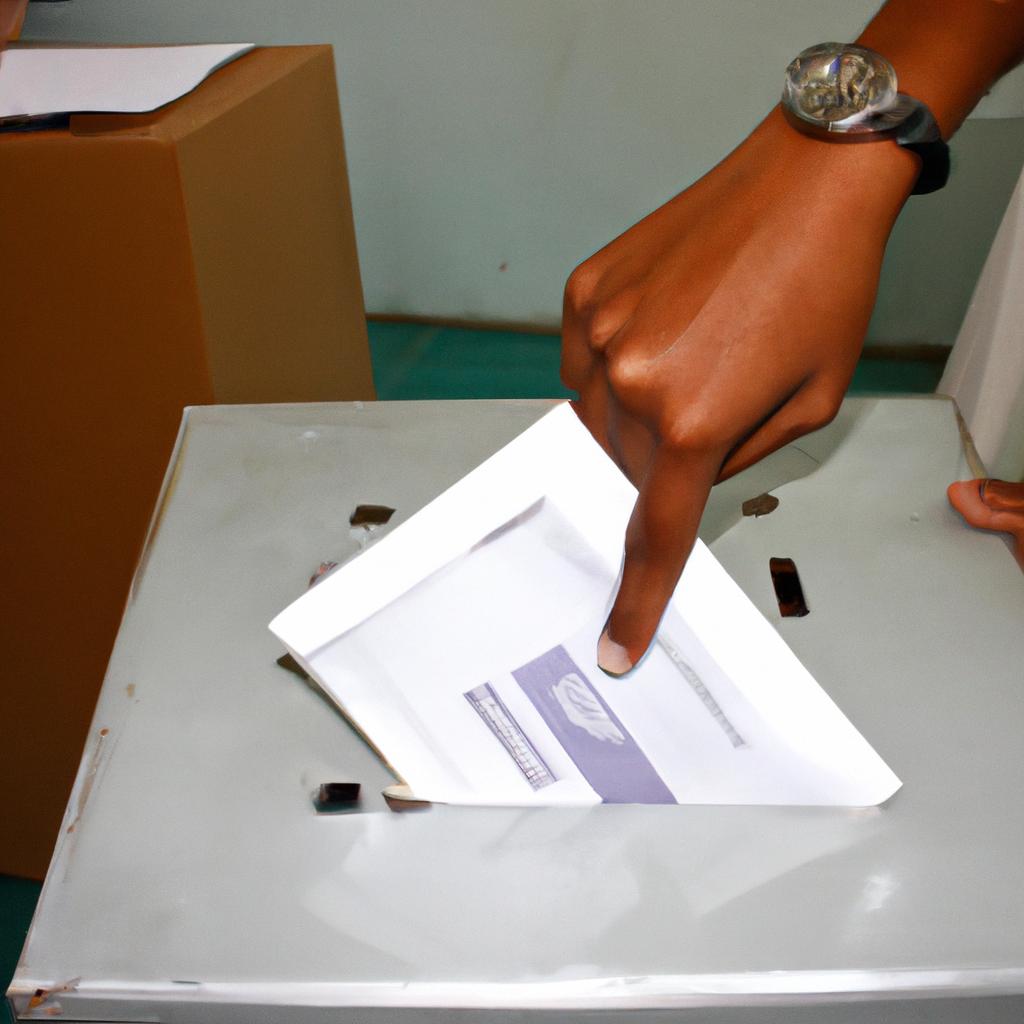The policy-making process in social sciences organizations is a complex and dynamic phenomenon that requires careful analysis from various disciplinary perspectives. This article focuses on the insights provided by political science, which offers valuable theoretical frameworks and empirical research to understand how policies are formulated, implemented, and evaluated within these organizations. To illustrate the significance of this inquiry, let us consider the hypothetical case study of an international development organization aiming to address poverty alleviation in a developing country.
In such a scenario, understanding the policy-making process becomes crucial as it involves multiple actors with diverse interests and preferences. Political science provides useful concepts such as agenda-setting, decision-making models, and institutional analysis to examine how different stakeholders shape policy outcomes. Moreover, examining power dynamics between organizational members can shed light on potential conflicts that may arise during policy formulation stages. By exploring these aspects through the lens of political science, we can gain deeper insights into the intricacies of policy making in social sciences organizations and enhance our ability to design effective interventions for addressing societal challenges.
Defining Policy Making Process
The policy making process in social sciences organizations is a complex and dynamic phenomenon that involves various stages and actors. To understand this process, it is essential to define what policy making entails.
Policy making can be broadly defined as the formulation, implementation, and evaluation of policies aimed at addressing societal issues or achieving specific objectives. It encompasses a range of activities, such as problem identification, agenda setting, decision-making, resource allocation, and policy implementation. One example of the policy making process is the development of environmental regulations to mitigate climate change impacts. This case study illustrates how multiple steps are involved in formulating effective policies.
To delve further into the intricacies of policy making in social sciences organizations, let us consider four key aspects:
- Complexity: Policy making processes often involve numerous stakeholders with diverse interests and perspectives. This complexity necessitates careful consideration of competing priorities and negotiation among different actors.
- Uncertainty: Policymakers frequently encounter uncertainties regarding the outcomes and effectiveness of their decisions. The inherent unpredictability associated with social issues adds an additional layer of complexity to policy making.
- Power dynamics: The distribution of power among various actors significantly influences policy choices and outcomes. Understanding power relations within social sciences organizations helps uncover underlying motivations behind certain policies.
- Contextual factors: Policies do not exist in isolation but are shaped by broader contextual factors such as political ideologies, societal norms, economic conditions, and cultural values. These contextual elements play a crucial role in shaping the direction and impact of policies.
Illustrating these aspects visually through a table allows for a better understanding:
| Aspects | Description |
|---|---|
| Complexity | Involves multiple stakeholders with different interests |
| Uncertainty | Decision outcomes may be unpredictable due to uncertain nature |
| Power dynamics | Distribution of power influences policy choices |
| Contextual factors | Broader context shapes policy direction |
In conclusion, policy making in social sciences organizations is a multifaceted process that encompasses various stages and involves different actors. Understanding the complexity, uncertainty, power dynamics, and contextual factors associated with this process is crucial for formulating effective policies. In the subsequent section, we will explore the key actors involved in policy making to shed further light on this intricate process.
[Transition sentence] Now let us turn our attention to the key actors who play pivotal roles in shaping policy decisions within social sciences organizations.
Key Actors in Policy Making
Transitioning smoothly from the previous section, let us now delve into an examination of the key actors involved in the policy making process. To illustrate this further, we will consider a hypothetical scenario involving a social sciences organization aiming to implement policies related to climate change.
In this case study, imagine that a research institute dedicated to environmental studies has identified the need for comprehensive policies addressing climate change mitigation and adaptation strategies. Several individuals and groups play pivotal roles in shaping these policies:
-
Elected officials: Politicians at local, national, or international levels have considerable influence over policy decisions. They are responsible for representing their constituents’ interests and formulating legislation aligned with broader societal goals.
-
Bureaucrats and civil servants: These professionals work within government departments or agencies and provide technical expertise on various aspects of policy formulation. Their role involves conducting research, analyzing data, and providing recommendations to elected officials.
-
Interest groups and advocacy organizations: Non-governmental entities such as environmental NGOs or industry associations often lobby for specific policy outcomes. Through various means like public campaigns, research publications, or direct engagement with policymakers, they attempt to shape the decision-making process.
-
Experts and academia: Researchers specializing in relevant disciplines offer valuable insights through scientific studies, empirical evidence, and expert opinions. Policymakers frequently seek input from academics who possess subject matter expertise when developing effective policies.
- Collaboration between stakeholders fosters robust decision-making processes.
- Inclusion of marginalized voices ensures equitable policy outcomes.
- Engaging with experts enhances evidence-based policymaking.
- Transparency throughout the process builds trust among citizens.
Furthermore, incorporating a table can help provide a concise overview of the various actors involved in policy making:
| Actors | Role and Responsibility | Examples |
|---|---|---|
| Elected officials | Representing constituents’ interests, formulating legislation | Members of Parliament |
| Bureaucrats | Providing technical expertise, conducting research | Environmental department officials |
| Interest groups | Lobbying for specific policy outcomes | Greenpeace, National Association of HSEs |
| Experts and academia | Offering insights through scientific studies | Climate scientists, Policy researchers |
In conclusion, understanding the key actors involved in the policy-making process is crucial for comprehending how policies are formulated. The hypothetical case study highlighted the roles played by elected officials, bureaucrats, interest groups, and experts/academia within a social sciences organization focused on climate change. By considering diverse perspectives and engaging with different stakeholders, policymakers can develop robust policies that address complex societal challenges.
Transitioning seamlessly into the subsequent section about “Identifying Policy Issues,” we will now explore how organizations identify relevant issues to inform their policy development efforts.
Identifying Policy Issues
Transitioning from the previous section on “Key Actors in Policy Making,” we now delve into the process of identifying policy issues within social sciences organizations. To illustrate this, let us consider a hypothetical scenario involving an education reform initiative.
In our example, policymakers are faced with the task of improving educational outcomes for students from disadvantaged backgrounds. This issue has gained significant attention due to widening achievement gaps and calls for greater equity in access to quality education. Identifying policy issues involves careful examination of underlying causes, potential solutions, and stakeholder perspectives.
To effectively identify policy issues, several key steps can be followed:
-
Research and Data Analysis:
- Conduct comprehensive research to understand the scope and magnitude of the problem.
- Use data analysis techniques to identify patterns, trends, and disparities related to educational outcomes.
-
Stakeholder Engagement:
- Engage diverse stakeholders such as educators, parents, community leaders, and policymakers.
- Seek input from these groups regarding their experiences, concerns, and ideas for addressing the identified issue.
-
Comparative Analysis:
- Analyze policies implemented by other jurisdictions or organizations facing similar challenges.
- Assess the effectiveness of those policies in achieving desired outcomes to inform decision-making.
-
Cost-Benefit Evaluation:
- Weigh the potential costs associated with implementing various policy options against their anticipated benefits.
- Consider short-term trade-offs versus long-term gains when evaluating different approaches.
By following these steps and engaging relevant actors throughout the process, policymakers can gain valuable insights into pressing policy issues within social sciences organizations.
Moving forward into the next section on “Policy Formulation and Analysis,” we explore how identified policy issues are translated into concrete strategies that address societal needs while considering political realities and resource constraints
Policy Formulation and Analysis
Section H2: Policy Formulation and Analysis
After identifying policy issues, organizations in social sciences often engage in a rigorous process of policy formulation and analysis. This stage involves carefully crafting policies that address the identified issues and analyzing their potential impacts. By taking this analytical approach, policymakers can ensure that their decisions are well-informed and considerate of various factors at play.
Policy Formulation:
During policy formulation, organizations delve into extensive research to develop comprehensive strategies for addressing the identified issues. For instance, let’s consider the hypothetical case study of an educational organization aiming to improve access to quality education for underprivileged students. In this scenario, policymakers would gather relevant data on existing educational disparities, examine successful initiatives implemented elsewhere, and consult with experts in the field.
To facilitate effective communication and decision-making during the formulation phase, organizations often employ different tools such as bullet point lists. These lists serve as concise summaries highlighting key considerations or guiding principles for developing policies. In relation to our case study example, a bullet point list may include items like:
- Ensuring equitable distribution of educational resources
- Promoting inclusive teaching practices
- Providing financial support to economically disadvantaged students
- Strengthening partnerships between schools and local communities
Policy Analysis:
Once policies have been formulated, they undergo thorough analysis before implementation. This critical step helps evaluate their feasibility and potential impact on stakeholders involved. Policymakers employ a range of analytical methods including cost-benefit analysis, stakeholder mapping, and risk assessment frameworks.
A useful tool commonly used during policy analysis is tables. Tables allow policymakers to present information systematically and compare different aspects related to policy options. Considering our earlier case study on improving access to quality education for underprivileged students, a table could be created outlining four key dimensions:
| Policy Options | Potential Benefits | Implementation Challenges |
|---|---|---|
| Scholarships | Increased enrollment | Limited funding availability |
| Community Outreach | Enhanced community engagement | Lack of resources and support from local authorities |
| Curriculum Adaptation | Tailored learning experiences for diverse students | Resistance to change within the education system |
| Teacher Training | Improved teaching quality | Time and financial constraints |
Policy formulation and analysis are crucial stages in the policy-making process. They ensure that policies are well-informed, evidence-based, and considerate of potential challenges. By employing tools such as bullet point lists and tables, organizations can streamline their decision-making processes while considering a range of factors.
As policy formulation and analysis reach completion, organizations move towards the subsequent stage of policy implementation and evaluation. This phase focuses on putting policies into action and assessing their effectiveness in achieving desired outcomes.
Policy Implementation and Evaluation
Building upon the policy formulation and analysis stage, policy implementation is a critical phase in the policymaking process. It involves translating policy decisions into action by executing specific programs or initiatives to achieve desired outcomes. To illustrate this concept further, let us consider the hypothetical case study of implementing a new educational reform policy aimed at improving student performance.
Once the policy has been formulated and analyzed, it moves on to the implementation stage. Successful implementation requires careful planning, effective coordination among various stakeholders, and adequate allocation of resources. Here are some key considerations during the implementation process:
- Capacity Building: Enhancing the skills and knowledge of educators through training programs ensures smooth execution of the reforms.
- Monitoring and Feedback Mechanisms: Regular monitoring allows for timely identification of challenges or issues that may hinder successful implementation. Feedback from teachers, students, parents, and other relevant parties can help refine policies as needed.
- Communication Strategies: Effective communication plays a crucial role in garnering support for the policy and ensuring its understanding among all stakeholders.
- Evaluation Frameworks: Establishing evaluation frameworks enables policymakers to assess the impact of implemented policies accurately.
To provide a visual representation of these considerations, we present a table highlighting their importance:
| Considerations | Examples |
|---|---|
| Capacity Building | Training workshops |
| Monitoring | Classroom observations |
| Communication | Stakeholder meetings |
| Evaluation Framework | Student performance tests |
By incorporating these factors into the policy implementation process, social science organizations strive to facilitate positive change within society. The ultimate goal is to improve overall well-being while addressing societal challenges effectively.
As policymakers navigate through each phase of the policymaking process—policy formulation and analysis followed by policy implementation—it becomes evident that several challenges exist along this journey. In upcoming sections, we will explore these obstacles further as we delve into an examination of “Challenges in Policy Making.”
Challenges in Policy Making
Building upon the previous section on policy making, this section delves into the crucial aspect of policy implementation and evaluation in social sciences organizations. To illustrate this process, let us consider a hypothetical case study involving a government initiative aimed at reducing unemployment rates among disadvantaged communities.
Once policies are formulated, they need to be effectively implemented to achieve their intended goals. However, numerous challenges can arise during this stage that hinder successful execution. These challenges include bureaucratic red tape, lack of coordination between different departments or agencies involved in implementation, insufficient resources allocated for implementation purposes, and resistance from stakeholders affected by the policy changes.
To navigate these obstacles, it is essential for policymakers to adopt effective strategies. The following bullet point list provides key considerations for ensuring smooth policy implementation:
- Clear communication channels: Establishing transparent lines of communication between policymakers and implementing agencies helps ensure clarity in roles and responsibilities.
- Adequate resource allocation: Providing sufficient financial and human resources enables effective execution of policies.
- Stakeholder engagement: Involving relevant stakeholders throughout the implementation process fosters ownership and collective responsibility.
- Regular monitoring and feedback mechanisms: Implementing robust monitoring systems aids in tracking progress, identifying bottlenecks early on, and facilitating timely adjustments as needed.
Furthermore, evaluating the impact of implemented policies is vital to gauge their effectiveness and make informed decisions regarding future directions. Policy evaluation involves assessing whether desired outcomes have been achieved, analyzing unintended consequences if any, measuring cost-effectiveness, and gathering feedback from those directly affected by the policies.
To better understand how policy implementation and evaluation work together within social sciences organizations’ decision-making processes, refer to Table 1 below:
| Aspects | Policy Implementation | Policy Evaluation |
|---|---|---|
| Goal | Execution of formulated policies | Assessing outcomes |
| Focus | Ensuring efficient delivery | Analyzing impacts |
| Timeframe | Ongoing process | Post-implementation |
| Key Actors | Implementing agencies, stakeholders | Evaluators, policymakers |
In summary, policy implementation and evaluation are integral components of the policy making process in social sciences organizations. Overcoming challenges during implementation requires effective strategies such as clear communication channels, adequate resource allocation, stakeholder engagement, and regular monitoring. Additionally, evaluating policies allows for informed decision-making based on outcomes achieved and feedback received. By understanding these aspects and employing best practices, policymakers can enhance the effectiveness of their initiatives to better serve communities in need.
Table 1: Comparison between Policy Implementation and Evaluation




